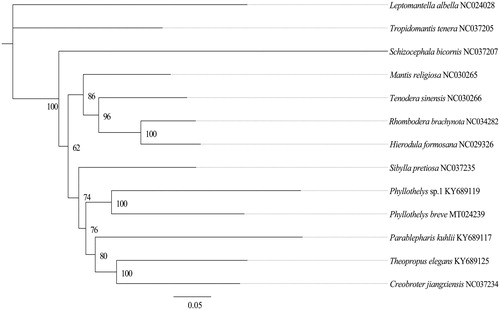Abstract
In this study, we determined the complete mitochondrial genome sequence of praying mantises Phyllothelys breve (Wang, 1993) (GenBank accession no. MT024239) using next-generation sequencing method. The mitogenome is 15,896 bp in length, consisting of 13 protein-coding genes (PCGs), two ribosomal RNA genes (rRNAs), 22 transfer RNA genes (tRNAs), and one non-coding control region. The overall nucleotide composition was 40.2% A, 35.5% T, 15.2% C, and 9.1% G, with 75.7% AT, respectively. The gene arrangement is consistent with the typical insect mitochondrial genome. Phylogenetic analysis revealed that P. breve clustered into a clade with congeneric species with high bootstrap support.
Mantodea commonly known as predatory insects with more than 2500 extant species (Patel and Singh Citation2016). Species of genus Phyllothelys Wood-Mason, with a process on the vertex, mainly distributed in southern China and Southeast Asia (Ehrmann and Roy Citation2009). Here, we determined the complete mitochondrial genome of Phyllothelys breve (Wang, 1993). The sampled specimen was collected from Jinghong, Yunnan, China (22°02′N, 100°55′E) in November 2018 and identified to species by morphology. The specimen was stored in the Entomological specimen room of Shangluo University (voucher no. Ma-2018101). The complete mitochondrial DNA sequence was determined using Illumina HiSeq 2500 Sequencing System (Illumina, San Diego, CA, USA). In total, 5.5 G raw reads were obtained, quality-trimmed, and assembled using MITObim version 1.7 (https://github.com/chrishah/MITObim) (Hahn et al. Citation2013).
The complete mitochondrial genome of P. breve was 15,896 bp in total length and deposited in GenBank database with an accession number MT024239. The overall base composition was 40.2% A, 35.5% T, 15.2% C, and 9.1% G, with an A + T ratio of 75.7%. The full mitochondrial genome contains 13 protein-coding genes (PCGs), 22 transfer RNAs (tRNAs), two ribosomal RNAs (rRNAs), and a putative control region (CR). The gene arrangement of P. breve is similar to that observed in family Mantidae praying mantises (Ye et al. Citation2016; Zhang and Ye Citation2017). All PCGs of P. breve have the conventional start codon for invertebrate mitochondrial PCGs (ATN), and nd4 and nd5 begin with ATA. Most of the PCGs terminate with the stop codon TAA, whereas cox2, nd4, and nd5 end with the incomplete codon T. Twenty-five genes were encoded on the major strand (J-strand), whereas the others were encoded on the minor strand (N-strand). Nine PCGs are encoded on the majority strand (J-strand) and four (nd5, nd4, nd4L, and nd1) on the minority strand (N-strand). Two rRNA genes (rrnL and rrnS) locate at trnL1/trnV and trnV/control regions, respectively, and both rRNA genes are encoded on the N-strand. The lengths of the two rRNA genes (rrnL and rrnS) in P. breve are about 1314 and 753 bp, with the A + T contents of 78.9% and 76.4%, respectively. The length of control region is 948 bp, with the AT content of this region is up to 77.4%.
To validate the phylogenetic position of P. breve, 13 mitochondrial protein-coding genes sequences were extracted from the complete mitochondrial DNA sequences of 12 closely related taxa of Mantodea. The phylogenetic tree was constructed using the maximum-likelihood method through IQtree 1.6.8 (Nguyen et al. Citation2015). Results showed that the family Mantidae is not monophyletic and P. breve clustered into a clade with congeneric species (), which was consistent with the previous studies (Legendre et al. Citation2015; Le-Ping et al. Citation2018; Shi et al. Citation2019). As a conclusion, we obtained and described the complete mitochondrial genome of P. breve, which constitute a valuable and useful resource for population genetic study and identification efforts on this species.
Disclosure statement
All authors have read and approved the final manuscript. No conflict of interest was reported by the authors.
Additional information
Funding
References
- Ehrmann R, Roy R. 2009. Taxonomy and synonymy of Phyllothelys Wood-Mason (Dictyoptera: Mantodea). Annales de la Société Entomologique de France. 45(1):67–76.
- Hahn C, Bachmann L, Chevreux B. 2013. Reconstructing mitochondrial genomes directly from genomic next-generation sequencing reads—a baiting and iterative mapping approach. Nucleic Acids Res. 41(13):e129–e129.
- Le-Ping Z, Dan-Na Y, Storey KB, Hong-Yi C, Jia-Yong Z. 2018. Higher tRNA gene duplication in mitogenomes of praying mantises (Dictyoptera, Mantodea) and the phylogeny within Mantodea. Int J Biol Macromol. 111:787–795.
- Legendre F, Nel A, Svenson GJ, Robillard T, Pellens R, Grandcolas P. 2015. Phylogeny of Dictyoptera: dating the origin of cockroaches, praying mantises and termites with molecular data and controlled fossil evidence. PLoS One. 10(7):e0130127.
- Nguyen LT, Schmidt HA, von Haeseler A, Minh BQ. 2015. IQ-TREE: a fast and effective stochastic algorithm for estimating maximum-likelihood phylogenies. Mol Biol Evol. 32(1):268–274.
- Patel S, Singh R. 2016. Updated checklist and distribution of Mantidae (Mantodea: Insecta) of the world. Int J Res Stud Zool. 2(4):17–54.
- Shi Y, Liu Q-P, Luo L, Yuan Z-L. 2019. Characterization of the complete mitochondrial genome sequence of Asiadodis yunnanensis (Mantidae: Choeradodinae) and phylogenetic analysis. Mitochondrial DNA B. 4(2):2826–2827.
- Ye F, Lan XE, Zhu WB, You P. 2016. Mitochondrial genomes of praying mantises (Dictyoptera, Mantodea): rearrangement, duplication, and reassignment of tRNA genes. Sci Rep. 6:25634.
- Zhang HL, Ye F. 2017. Comparative mitogenomic analyses of praying mantises (Dictyoptera, Mantodea): origin and evolution of unusual intergenic gaps. Int J Biol Sci. 13(3):367–382.

